Zacatecas
by Don Bailey from Don Bailey, State and Federal Copper And Brass Coinage Of Mexico (1824 – 1872), Don Bailey Institute for Mexican Numismatic & Historical research, 2008
Flying Eros
The Zacatecas rnint issued, in the author's view, the prettiest coin of the state copper series. Known as the "Angel" or "Flying Eros", this coin, which covers a span of forty years, remained basically the sarne. The obverse has a flying Eros holding an arrow with a liberty cap and rays at its end. The city of Zacatecas and the hill of La Bufa are below.
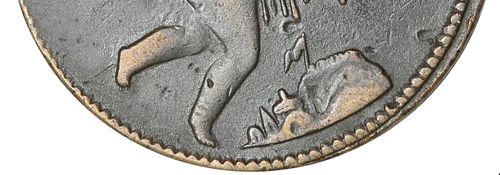
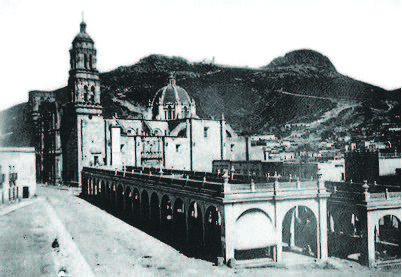
This is an 1870s view of Zacatecas cathedral and the Cerro de la Bufa in the background from the Plaza del Tianguis. This seems to be nearly the viewpoint for the design motif below Eros on the coinage. The buildings on the Zacatecas state copper seem to include the cathedral in the city proper and also possibly the fort that sits in the saddle between the two peaks of the Cerro de la BufaGreg Meyer, “Context of the Zacatecas State Copper Design” in USMexNA journal, June 2013.
The reverse has a pyramid holding up an open book of laws and a wreath. The legend around is either "ESTo. LIBE. FEDo. DE ZACATECAS" or "DEPARTAMENTO DE ZACATECAS". These issues are all in brass. The edges of these issues are all obliquely reeded.
⅛ real


KM 338 ⅛r 1863 Zacatecas Reversed 6 in date (Stack’s Bowers auction, 22 October 2020, lot 72560)
The ⅛ real was struck in 1825, 1827, 1829 through 1833 and 1835 with the " ESTo. LIBE." legend, and in 1836 and 1846 with the "DEPARTAMENTO" legend. In 1846 the " ESTo. LIBE." legend was resumed, and coins were struck in 1846, 1850, 1851, 1852, 1858, and 1862 through 1863.
Medallic orientation (↑↑) to 1836, 1850 and some 1851s which may be counterfeits. Coin orientation (↑↓) 1846 and later.
An 1825 octavo presentation strike in silver is also known.
| KM 338 | ESTo. LIBE | 1825 | 21mm | |
| LEBE | ||||
| 1827 | ||||
| inverted A used for V in OCTAVO | ||||
| 1829 | ||||
| 1830 | ||||
| 1831 | Zaoatecas | |||
| 1832 | ||||
| 1833 | Zaoateoas | |||
| 1.833 | ||||
| Zacatecas | ||||
| 1835 | ||||
| 1846 | ||||
| 185 | Final digit missing | |||
| 1850 | ||||
| 1851 | ||||
| 1852/1 | ||||
| 1852 | ||||
| 1858 | ||||
| 1859 | ||||
| 1862 | ||||
| 1863 | All with backward 6 in date |


KM 339 ⅛r 1846 Zacatecas
| KM 339 | DEPARTAMENTO DE ZACATECAS |
1836 | 21mm | |
| 1846 |
¼ real
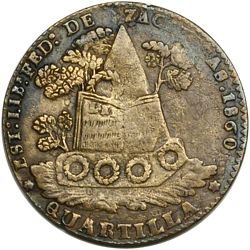
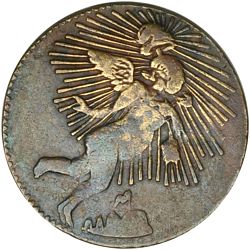
KM 366 ¼r 1860 Zacatecas (Stack’s Bowers Baltimore auction, 28 March 2011, lot 8078)
The ¼ real was struck in brass with the legend "ESTo LIBE FEDo DE ZACATECAS" 1824 (a pattern) to 1827, 1829 to 1835, 1846, 1847, 1852, 1853, 1855, 1858 to 1860, and 1862 to 1864. ¼ reales were struck with the inscription "DEPARTAMENTO DE ZACATECAS" for the years 1836 and 1846.
Medallic orientation (↑↑) to 1836. Coin orientation (↑↓) 1846 and after.
| KM 366 | ESTo. LIBE | 1824 | 29mm | pattern |
| 1825 | ||||
| 1826 | ||||
| 1827 | ||||
| 1827/17 | ||||
| 1829 | ||||
| 1830 | ||||
| 1831 | ||||
| 1832 | ||||
| 1833/2 | ||||
| 1834 | ||||
| 1835 | ||||
| 1846 | ||||
| 1847 | ||||
| 1851 | likely circulating counterfeits | |||
| 185 | digit missing | |||
| 1852 | ||||
| 1853 | ||||
| 1855 | ||||
| 1858 | ||||
| 1859/8 | ||||
| 1859 | ||||
| 1860 | ||||
| 1862 | ||||
| 1862/57 | O/Ds are unreadable | |||
| 1863 | ||||
| 1863/2 | ||||
| 18 2 | digit missing |
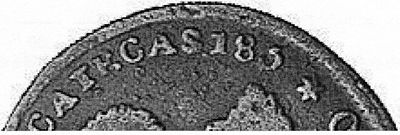
KM 366 ¼ real Zacatecas 185 (missing digit)
Counterstamps
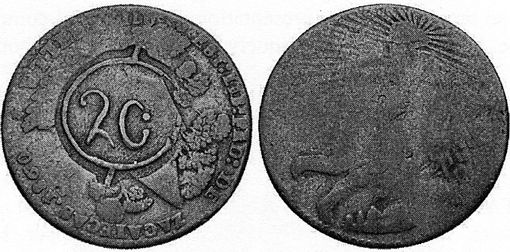
KM 366 ¼ real 1860 Zacatecas counterstamped 2C

KM 367 ¼r 1846 Zacatecas (Briggs & Bustos auction, 3 September 2023, lot 36
| KM 367 | DEPARTAMENTO DE ZACATECAS | 1836 | 29mm | |
| 1845 | known only as a contemporary counterfeit | |||
| 1846 |
There are many varieties of misspelling, missing letters and inverted letters, mostly in the 1827-1833 period, as well as coins made of copper metal, many of which are contemporary counterfeits.
Some of the dates that we accept as genuine may be contemporary fakes. When studying the Zacatecas series, consider the following:
1. Edge reeding is very distinctive and difficult to counterfeit. Regular obligue reeding is sometímes found without borders and should be considered suspect.
2. Planchet sizes are sometimes found that are smaller in diameter and thickness. Irregular thickness is not likely found on genuine issues. Sorne may be cast before striking. Fake planchets are sometímes more difficult to produce in quantity than a quality die. Thick planchets are also known and are not likely mint products.
3. Lettering may be crude to the extreme. Consider substitute letters but genuine coins may sometimes utilize incorrect letters.
4. Irregular mix of alloys should be considered. However oxidation may give the look of copper. Sorne Zacatecas coins listed as copper in recent large auctions were found to be oxidized brass.
Study and intuition may provide strong evidence that a coin is bogus but in many cases definite proof may never be established. And contemporary counterfeits have great interest as historical items. However, when dealing with dates thought to be fictitious, every effort must be made to determine the true origin.
MintagesOther sources mention 1825-1842 $179,949.50, 1842-187 $114,600.00
| ⅛ real No. of coins |
¼ real No of coins |
Total value | |
| 1824-1827 | $30,200.00 | ||
| 1828-1829 | 77,749.50 | ||
| 1830-1847 | 72,000.00 | ||
| 1856 | 30,000.00 | ||
| 1858-1863 | 75,000.00 |
